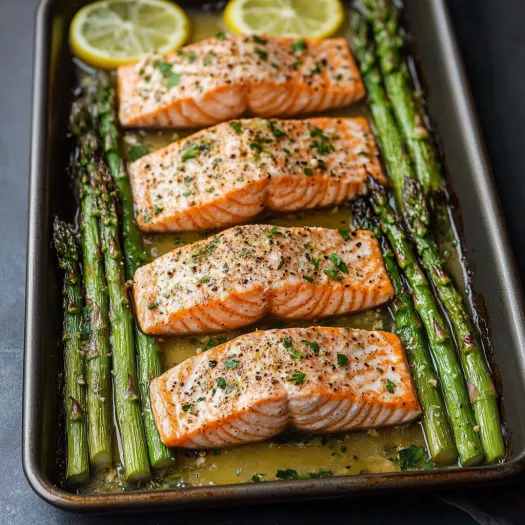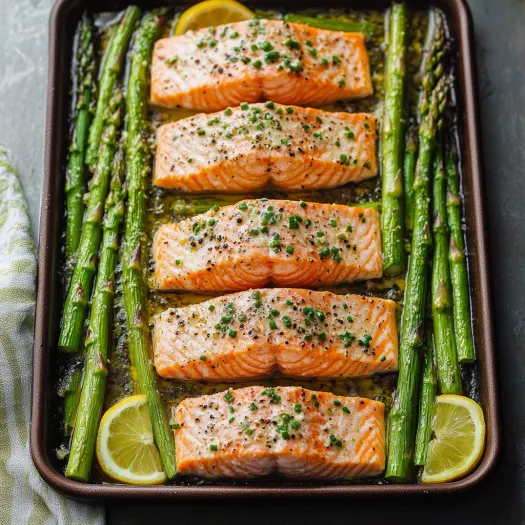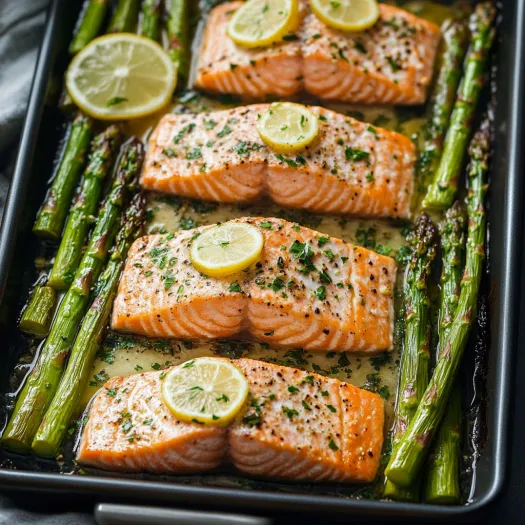 Pin
Pin
This foil-wrapped salmon and asparagus turns an ordinary dinner into something special without spending forever in the kitchen. Cooking everything in foil keeps the fish juicy while bathing both salmon and veggies in that tasty garlic butter mixture.
I whipped this up during last spring's asparagus peak when friends showed up unexpectedly for dinner. Now it's my favorite thing to make when company comes because it looks fancy but takes barely any work.
Ingredients
- Salmon fillets: Pick ones that feel firm, have bright color, and smell mildly like the ocean showing they're fresh
- Vegetable or chicken broth: Gives deep flavor without extra fat
- Lemon juice: Adds zing and cuts through the salmon's richness
- Hot sauce: Brings just enough heat to balance the buttery goodness
- Minced garlic: Go with fresh for the strongest smell and taste
- Butter: Makes that smooth sauce coating everything
- Fresh parsley or cilantro: Brings color and fresh herb flavors
- Asparagus: Medium-thick stems work best since they won't overcook
Step-by-Step Instructions
- Heat Your Oven:
- Turn it to 425°F and wait for it to get fully hot while getting everything ready. This high heat quickly locks in all the good flavors and moisture.
- Cut Your Foil:
- Get two pieces of heavy-duty aluminum foil around 14x12 inches each. They need to be big enough to wrap everything with room for steam. If you've only got regular foil, just use two layers.
- Mix Up The Sauce:
- In a small bowl, stir together broth, lemon juice and hot sauce until well mixed. Then drop in the garlic and butter chunks. This will melt as it cooks to make that yummy sauce that flavors everything.
- Build Your Packets:
- Grab some paper towels and dry the salmon completely so it'll brown better. Season both sides with salt and pepper. Put each piece in the middle of a foil sheet. Lay asparagus spears beside the salmon, sharing them evenly. Pour half the sauce mix over each packet, making sure to get both fish and veggies.
- Wrap And Cook:
- Fold the foil over everything and crimp the edges closed to make a sealed packet. Leave a bit of space inside for steam. Put them on a baking sheet and cook for 9-12 minutes, depending on how thick your salmon is.
- Open And Enjoy:
- Carefully open the packets - watch out for hot steam! The salmon should break apart easily with a fork but still be moist inside. Squeeze on more fresh lemon if you want, and sprinkle lots of chopped herbs before serving.

The zingy lemon mixed with that rich buttery sauce makes such a good combo that even my nephew who usually hates fish cleans his plate without complaining. Last summer at a backyard get-together, my friend's little girl asked if I'd teach her mom how to make it because she wanted to eat it every single week.
Perfect Pairing Suggestions
This salmon tastes best with simple sides that don't fight for attention. Try a basic rice pilaf or some crusty bread to soak up that amazing sauce. If you're drinking wine, go for something light like Sauvignon Blanc or a gentle Pinot Noir that won't overwhelm the fish's subtle flavors.
Ingredient Substitutions
This dish is super adaptable when you don't have everything on hand. No asparagus? Try green beans or broccoli pieces depending what's in season. You can swap the butter for olive oil for a different taste, though your sauce won't be quite as luxurious. When fresh herbs aren't around, just use dried ones but cut the amount in half.
Identifying When Salmon is Done
Lots of home cooks aren't sure when salmon is perfectly cooked. Your fish should be moist, tender and break apart easily with a fork. For best results, look for an internal temp of about 125°F. The salmon will keep cooking a bit after you take it out. Just remember wild salmon gets done faster than farmed kinds because it's not as fatty.
Seasonal Adaptations
You can tweak this dish throughout the year. During summer, throw in some cherry tomatoes for sweet pops of flavor. In fall, try adding sliced fennel or leeks. Winter versions taste great with thin potato slices tucked under the salmon. The cooking method stays the same while different seasonal veggies keep things interesting all year.

Recipe Q&A
- → How do I prevent overcooking the salmon?
Take a peek at the salmon after 9 minutes. It's done when you can easily flake it with a fork and it hits 145°F (63°C) inside.
- → Can I use a different vegetable instead of asparagus?
For sure! Try green beans, zucchini slices, or broccoli florets instead. Just watch your cooking time so everything finishes together.
- → What can I use instead of foil for baking?
Parchment paper does the trick too. Just make a pouch and fold the edges tightly to keep all the juices inside.
- → Can I make this dish dairy-free?
You can swap out the butter for margarine or any plant-based spread to make this work for dairy-free eaters.
- → How can I add more flavor to the dish?
Toss in some thyme or rosemary sprigs or scatter some grated Parmesan on the veggies before they go in the oven.
